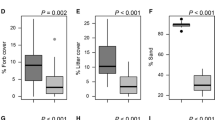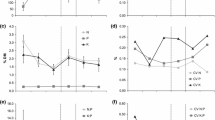Abstract
Grazing and seasonal variation in precipitation and temperature are important controls of soil and plant processes in grasslands. As these ecosystems store up to 30% of the world’s belowground carbon (C), it is important to understand how this variability affects mineral soil C pools/fluxes, and how C cycling might be affected by changes in precipitation and temperature, due to climate change. The aim of this study was to investigate the effects of grazing and differences in soil temperature and moisture on standard organic matter (OM) decomposition rates (cotton cloth) incubated in the top 10 cm soil of grasslands with variable topography in Yellowstone National Park (YNP) during the 2004 growing season. Grazing did not affect soil temperature, moisture, cotton cloth decomposition rates, soil bulk density, soil C and N concentrations, or soil C:N ratios. However, a large spatio-temporal variability in decomposition was observed: cotton cloth decomposition was positively related to soil moisture and soil C and N concentrations, and negatively to soil temperature. Highest decomposition rates were found in wetter slope bottom soils [season averages of decomposition given as rate of decomposition (cotton rotting rate = CRR) = 23–26%] and lower rates in drier, hill-top soils (season averages, CRR = 20%). Significantly higher decomposition rates were recorded in spring, early summer and early fall when soils were moist and cool (spring, CRR = 25%; early summer, CRR = 26%; fall, CRR = 20%) compared to mid-summer (CRR = 18%) when soils were dry and warm. Our findings suggest that climate-change related decreases in precipitation and increases in temperature predicted for North American grasslands would decrease soil OM decomposition in YNP, which contrasts the general assumption that increases in temperature would accelerate OM decomposition rates.



Similar content being viewed by others
References
Anderson JM (1991) The effects of climate change on decomposition processes in grassland and coniferous forests. Ecol Appl 1:326–347
Augustine DJ, Frank DA (2001) Effects of migratory grazers on spatial heteogeneity of soil nitrogen properties in a grassland ecosystem. Ecology 82:3149–3162
Bardgett RD, Wardle DA (2003) Herbivore-mediated linkages between aboveground and belowground communities. Ecology 84:2258–2268
Bellamy PH, Loveland PJ, Bradler RI, Lark RM, Kirk GJ (2005) Carbon losses from all soils across England and Wales 1978–2003. Nature 437:245–248
Berg B (2000) Litter decomposition and organic matter turnover in northern forest soils. For Ecol Manag 133:13–22
Binkley D, Singer F, Kaye M, Rochelle R (2003) Influence of elk grazing on soil properties in Rocky Mountain National Park. For Ecol Manag 185:239–247
Briggs JM, Knapp AK (1995) Interannual variability in primary production in tallgrass prairie: climate, soil moisture, topographic position, and fire as determinants of aboveground biomass. Am J Bot 82:1024–1030
Coughenour MB (1991) Biomass and nitrogen responses to grazing of upland steppe in Yellowstone's northen winter range. J Appl Ecol 28:71–82
Drewnik M (2006) The effect of environmental conditions on the decomposition rat of cellulose in mountain soils. Geoderma 132:116–130
Epstein HE, Burke IC, Lauenroth WK (2002) Regional patterns of decomposition and primary production rates in the U.S. Great Plains. Ecology 83:320–327
Eswaran H, van den Berg E, Reich P (1993) Organic carbon in soils of the world. Soil Sci Soc Am J 57:192–194
Frank DA (2007) Drought effects on above- and belowground production of a grazed temperate grassland ecosystem. Oecologia 152:131–139
Frank DA, Groffmann PM (1998) Ungulate vs landscape control of soil C and N processes in grasslands of Yellowstone National Park. Ecology 79:2229–2241
Ganjegunte GK, Vance GF, Preston CM, Schuman GE, Ingram LJ, Stahl PD, Welcker JM (2005) Soil organic carbon composition in a Northern mixed-grass prairie: effects of grazing. Soil Sci Soc Am J 69:1746–1756
Güsewell S, Jewell PL, Edwards P (2005) Effects of heterogeneous habitat use by cattle on nutrient availability and litter decomposition in soils of an Alpine pasture. Plant Soil 268:135–149
Hill MO, Latter PM, Bancroft G (1985) Standard curve for inter-site comparison of cellulose degradation using the cotton strip method. Can J Soil Sci 65:609–619
Homann P, Grigal DF (1996) Below-ground organic carbon and decomposition potential in a field-forest glacial-outwash landscape. Biol Fert Soils 23:207–214
Hopkins DW, Ibrahim IM, O’Donnell AG, Shiel RS (1990) Decomposition of cellulose, soil organic matter and plant litter in a temperate grassland soil. Plant Soil 124:79–85
Ineson PP, Bacon PJ, Lindley DK (1988) Decomposition of cotton strips in soil: analysis of the world data set. In: Harrison AF, Latter PM, Walton DWH (eds) Cotton strip assay: an index for decomposition in soils. Institute of Terrestrial Ecology, Grange-Over-Sands, England, pp 155–165
IPCC (2001) Intergovernmental Panel on Climate Change. Third assessment report
James SE, Pärtel M, Wilson SD, Peltzer DA (2003) Temporal heterogeneity of soil moisture in grassland and forest. J Ecol 9:234–239
Jenkinson DS, Adams DE, Wild A (1991) Model estimates of CO2 emissions from soil in response to global warming. Nature 351:304–306
Johnson LC, Matchett JR (2001) Fire and grazing regulate belowground processes in tallgrass prairie. Ecology 82:3377–3389
Jurgensen M, Reed D, Page-Dumroese D, Laks P, Collings A, Mroz G, Degorski M (2006) Wood strength loss as a measure of decomposition in northern forest mineral soil. Europ. J Soil Biol 42:23–31
Keefer WR (1987) The geological story of Yellowstone National Park. Yellowstone library and Museum Association, Mammoth, WY
Kirschbaum MUF (1995) The temperature dependence of soil organic matter decomposition, and the effect of global warming on soil organic C storage. Soil Biol Biochem 27:753–760
Knapp AK, Fahnestock TH, Hamburg SJ, Statland LB, Seastedt TR, Schimel DS, (1993) Landscape patterns in soil-plant water relations and primary production in tall-grass. Ecology 74: 549–560
Knapp AK, Fay PA, Blair JM, Collins SL, Smith MD, Carlisle JD, Harper CW, Danner BT, Lett MS, McCarron JK (2002) Rainfall variability, carbon cycling and plant species diversity in a mesic grassland. Science 298:2202–2205
Koukoura Z, Mamolos AP, Kalburtji KL (2003) Decomposition of dominant plant species litter in semi-arid grassland. Appl Soil Ecol 23:13–23
Latter PM, Howson G (1977) The use of cotton strips to indicate cellulose decomposition in the field. Pedobiologia 17:145–155
Latter PM, Walton D (1988) The cotton strip assay for cellulose decomposition studies in soil: history of the assay and development. In: Harrison AF, Latter PM, Walton DWH (eds) Cotton strip assay: an index for decomposition in soils. Institute of Terrestrial Ecology, Grange-Over-Sands, England, pp 7–9
Lauenroth WK, Sala OE (1992) Long-term forage production of North American shortgrass steppe. Ecol Appl 2:397–403
LeCain DR, Morgan JA, Schuman GE, Reeder JD, Hart RH (2000) Carbon exchange rates in grazed and ungrazed pastures of Wyoming. J Range Manag 53:199–206
LeCain DR, Morgan JA, Schuman GE, Reeder JD, Hart RH (2002) Carbon exchange and species composition of grazed pastures and exclosures in the short-grass steppe of Colorado. Agric Ecosyst Environ 93:421–435
Lieth H (1978) Pattern of primary productivity in the biosphere. Hutchinson & Ross, Stroudsberg, PA
McNaughton SJ (1984) Grazing lawns: animals in herds, plant form, and coevolution. Am Nat 124:863–886
McNaughton SJ (1985) Ecology of a grazing ecosystem: the Serengeti. Ecol Monogr 55:259–295
McNaughton SJ, Banyikawa FF, McNaughton MM (1997) Promotion of the cycling of diet-enhancing nutrients by African grazers. Science 278:1798–1800
Murphy KL, Klopatek JM, Klopatek CC (1998) The effects of litter quality and climate on decomposition along an elevational gradient. Ecol Appl 8:1061–1071
Northern Yellowstone Cooperative Wildlife Working Group (1996–2004) Annual reports 1996 to 2004
Olofsson J, Oksanen L (2002) Role of litter decomposition for the increased primary production in areas heavily grazed by reindeer: a litter bag experiment. Oikos 9:507–515
Quinn GP, Keough MJ (2002) Experimental design and data analysis for biologist. Cambridge, Cambridge, p 537
Raiesi F, Asadi E (2006) Soil microbial activity and litter turnover in native grazed and ungrazed rangelands in a semiarid ecosystem. Biol Fertil Soils 43:76–82
Risch AC, Frank DA (2006) Carbon dioxide fluxes in a spatially and temporally heterogeneous temperate grassland. Oecologia 147:291–302
Sagar BF (1988) The Shirley soil burial test fabric and tensile testing as a measure of biological breakdown of textiles. In: Harrison AF, Latter PM, Walton DWH (eds) Cotton strip assay: an index for decomposition in soils. Institute of Terrestrial Ecology, Grange-Over-Sands, England, pp 11–16
Schimel D, Stillwell MA, Woodmansee RG (1985) Biogeochemistry of C, N and P in a soil catena of the short-grass steppe. Ecology 66:276–283
Seastedt TR, Ramundo RA, Hayes DC (1988) Maximization of densities of soil animals by foliage herbivory: empirical evidence, graphical, and conceptual models. Oikos 51:243–248
Shariff AR, Biondini ME, Grygiel CE (1994) Grazing intensity effects on litter decomposition and soil nitrogen mineralization. J Range Manag 47:444–449
Shaw MR, Harte J (2001) Control of litter decomposition in a subalpine meadow-sagebrush steppe ecotone under climate change. Ecol Appl 11:1206–1223
Shibu ME, Leffelaar PA, Van Keulen H, Aggarwal PK (2006) Quantitative description of soil oranic matter dynamics - a review of approaches with reference to rice-based cropping systems. Geoderma 137:1–18
Smith VC, Bradford MA (2003) Litter quality impacts on grassland litter decomposition are differently dependent on soil fauna across time. Appl Soil Ecol 24:197–203
Smith P, Powlson DS, Smith JU, Elliot TE (1997) Evaluation and comparison of soil organic matter models using long-term datasets. Geoderma 81:1–255
Smith J, Smith P, Wattenbach M, Zaehle S, Hiedere R, Jones RJA, Montanarella L, Rounsevelle MDA, Reginster I, Ewert F (2005) Projected changes in mineral soil carbon of Europan croplands and grasslands, 1990–2080. Glob Change Biol 11:2141–2151
Soil Survey Staff (2003) Keys to soil taxonomy, 9th edn. U.S. Department of Agriculture, Natural Resources Conservation Service. Washington, DC: U.S. Govt. Print. Office, p 332
Tietjen B, Jeltsch F (2007) Semi-arid grazing systems and climate change: a survey of present modelling potential and future needs. J Appl Ecol 44:425–434
Wan S, Luo Y (2003) Substrate regulation of soil respiration in a tallgrass prairie: results of a clipping and shading experiment. Global Biogeochem Cycl 17:1054–1065
Wardle DA, Bonner KI, Barker GM (2002) Linkages between plant litter decomposition, litter quality and vegetation responses to herbivores. Funct Ecology 16:585–595
Withington CL, Sanford RL Jr (2007) Decomposition rates of buried substrates increase with altitude in the forest-alpine tundra ecotone. Soil Biol Biochem 39:68–75
Acknowledgements
We thank Jessica Gale, Sara Taylor, Eric Weiss, Timothy DePriest, Anna Stewart, Michelle Niemelä and the USDA Forest Service Laboratory in Moscow, Idaho for their assistance in the field and laboratory work, Martin Schütz and the anonymous reviewers for constructive comments on the manuscript. We are grateful for the support by the Yellowstone National Park Service administration. This project was funded by US-NSF grant DEB-0318716, Swiss-NSF fellowships PBEZ-104320 and PBEZA-104320 and the vegetation-soils subproject of the Swiss-NFI.
Author information
Authors and Affiliations
Corresponding author
Additional information
Responsible Editor: Barbara Wick.
Rights and permissions
About this article
Cite this article
Risch, A.C., Jurgensen, M.F. & Frank, D.A. Effects of grazing and soil micro-climate on decomposition rates in a spatio-temporally heterogeneous grassland. Plant Soil 298, 191–201 (2007). https://doi.org/10.1007/s11104-007-9354-x
Received:
Accepted:
Published:
Issue Date:
DOI: https://doi.org/10.1007/s11104-007-9354-x




